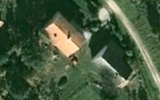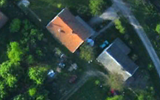Orthophoto
Aerial photograph geometrically corrected to be map-accurate
Orthophoto[edit]
An orthophoto, also known as an orthophotograph, is an aerial photograph that has been geometrically corrected, or "orthorectified," so that the scale is uniform. Unlike an uncorrected aerial photograph, an orthophoto can be used to measure true distances, as it is an accurate representation of the Earth's surface, having been adjusted for topographic relief, lens distortion, and camera tilt.

Creation Process[edit]
The creation of an orthophoto involves several steps:
Aerial Photography[edit]
The process begins with the capture of aerial images using a camera mounted on an aircraft. These images are taken from multiple angles to ensure comprehensive coverage of the area.
Geometric Correction[edit]
The raw images are then processed to correct for distortions caused by the camera lens, the angle of the camera, and the topography of the land. This process is known as orthorectification.
Digital Elevation Model (DEM)[edit]
A Digital Elevation Model is used to account for variations in terrain. The DEM provides the necessary data to adjust the image so that it accurately reflects the Earth's surface.
Mosaicking[edit]
Multiple orthophotos are often combined to create a seamless image of a larger area. This process is known as mosaicking.

Applications[edit]
Orthophotos are used in a variety of fields due to their accuracy and detail:
Urban Planning[edit]
In urban planning, orthophotos provide a detailed and accurate base map for planning and development.
Environmental Studies[edit]
They are used in environmental studies to monitor changes in land use, vegetation, and water bodies over time.
Agriculture[edit]
In precision agriculture, orthophotos help in assessing crop health and planning irrigation systems.
Disaster Management[edit]
Orthophotos are crucial in disaster management for assessing damage and planning recovery efforts.

Advantages[edit]
Orthophotos offer several advantages over traditional maps and photographs:
- Accuracy: They provide a true-to-scale representation of the Earth's surface.
- Detail: High-resolution orthophotos offer detailed imagery that can reveal features not visible on traditional maps.
- Versatility: They can be used in conjunction with other geographic information system (GIS) data for enhanced analysis.
Limitations[edit]
Despite their advantages, orthophotos have some limitations:
- Cost: The process of creating orthophotos can be expensive due to the need for specialized equipment and software.
- Time: Producing orthophotos is time-consuming, especially for large areas.

Related Pages[edit]

See Also[edit]

External Links[edit]
- [Orthophoto resources at USGS]
- [Orthophoto applications in urban planning]
Ad. Transform your life with W8MD's Budget GLP-1 injections from $75


W8MD offers a medical weight loss program to lose weight in Philadelphia. Our physician-supervised medical weight loss provides:
- Weight loss injections in NYC (generic and brand names):
- Zepbound / Mounjaro, Wegovy / Ozempic, Saxenda
- Most insurances accepted or discounted self-pay rates. We will obtain insurance prior authorizations if needed.
- Generic GLP1 weight loss injections from $75 for the starting dose.
- Also offer prescription weight loss medications including Phentermine, Qsymia, Diethylpropion, Contrave etc.
NYC weight loss doctor appointmentsNYC weight loss doctor appointments
Start your NYC weight loss journey today at our NYC medical weight loss and Philadelphia medical weight loss clinics.
- Call 718-946-5500 to lose weight in NYC or for medical weight loss in Philadelphia 215-676-2334.
- Tags:NYC medical weight loss, Philadelphia lose weight Zepbound NYC, Budget GLP1 weight loss injections, Wegovy Philadelphia, Wegovy NYC, Philadelphia medical weight loss, Brookly weight loss and Wegovy NYC
|
WikiMD's Wellness Encyclopedia |
| Let Food Be Thy Medicine Medicine Thy Food - Hippocrates |
Medical Disclaimer: WikiMD is not a substitute for professional medical advice. The information on WikiMD is provided as an information resource only, may be incorrect, outdated or misleading, and is not to be used or relied on for any diagnostic or treatment purposes. Please consult your health care provider before making any healthcare decisions or for guidance about a specific medical condition. WikiMD expressly disclaims responsibility, and shall have no liability, for any damages, loss, injury, or liability whatsoever suffered as a result of your reliance on the information contained in this site. By visiting this site you agree to the foregoing terms and conditions, which may from time to time be changed or supplemented by WikiMD. If you do not agree to the foregoing terms and conditions, you should not enter or use this site. See full disclaimer.
Credits:Most images are courtesy of Wikimedia commons, and templates, categories Wikipedia, licensed under CC BY SA or similar.
Translate this page: - East Asian
中文,
日本,
한국어,
South Asian
हिन्दी,
தமிழ்,
తెలుగు,
Urdu,
ಕನ್ನಡ,
Southeast Asian
Indonesian,
Vietnamese,
Thai,
မြန်မာဘာသာ,
বাংলা
European
español,
Deutsch,
français,
Greek,
português do Brasil,
polski,
română,
русский,
Nederlands,
norsk,
svenska,
suomi,
Italian
Middle Eastern & African
عربى,
Turkish,
Persian,
Hebrew,
Afrikaans,
isiZulu,
Kiswahili,
Other
Bulgarian,
Hungarian,
Czech,
Swedish,
മലയാളം,
मराठी,
ਪੰਜਾਬੀ,
ગુજરાતી,
Portuguese,
Ukrainian